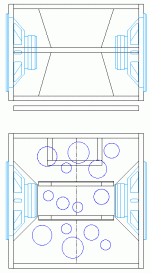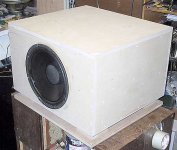I am curious over plus/minus of how to implement two subwoofers.
I have seen two subwoofers in one larger cabinet laying down under the screen and I have seen two individual cabinets positioned around the room (say two front corners for example)
Thoughts? Assuming an 80Hz or lower crossover. The obvious negatives to two cabinets is two amps if they are built into the cabinets..I guess I could use a stereo amp. Plus there are two complete cabinets to build vs. one larger one.
What about sensitivity?
Jim
I have seen two subwoofers in one larger cabinet laying down under the screen and I have seen two individual cabinets positioned around the room (say two front corners for example)
Thoughts? Assuming an 80Hz or lower crossover. The obvious negatives to two cabinets is two amps if they are built into the cabinets..I guess I could use a stereo amp. Plus there are two complete cabinets to build vs. one larger one.
What about sensitivity?
Jim
smithsonga my preference is one sub
soundstage=one drummer and in the bass region under 80 hz it is non directional....depending on what type of speakers you are using for your main speakers and the orientation they are setup and the acoustic properties in your room. you have asked a tough question
soundstage=one drummer and in the bass region under 80 hz it is non directional....depending on what type of speakers you are using for your main speakers and the orientation they are setup and the acoustic properties in your room. you have asked a tough question
Yes, I agree with Joe. It depends on your room and speaker set-up.
Provided you use a fairly steep low-pass slope on your filter, you shouldn't have problems with direction so the only question is how the bass is best loaded into the room.
There's a lot to be said for placing a single sub in the corner and thus engaging all of the room modes. On the other hand, if your corners are too far away from the listening position or nearer than the main speakers this may not be ideal.
An advantage of using two bass drivers in one enclosure is that you can mount them push-push to partially cancel the vibrations of the drivers so this is something to bear in mind (Dave, are you out there?).
I have designed my own subs (one single and one push-push) so that they can be stacked and placed in the corner if desired. Why not build two boxes but make them stackable?
Provided you use a fairly steep low-pass slope on your filter, you shouldn't have problems with direction so the only question is how the bass is best loaded into the room.
There's a lot to be said for placing a single sub in the corner and thus engaging all of the room modes. On the other hand, if your corners are too far away from the listening position or nearer than the main speakers this may not be ideal.
An advantage of using two bass drivers in one enclosure is that you can mount them push-push to partially cancel the vibrations of the drivers so this is something to bear in mind (Dave, are you out there?).
I have designed my own subs (one single and one push-push) so that they can be stacked and placed in the corner if desired. Why not build two boxes but make them stackable?
Hi Joe and Steve,
I guess I have to partly disagree with you on this one. I have found the stereo image to be much more stable with stereo subs. I'll agree that the room will have an influence on this and may well be part of what I've experienced, but each time I tried a mono sub, or dual mono subs, the stereo image suffered. Just for the record, my hi-pass is first order @ 90Hz and my lo-pass is 3rd order @ 80Hz. I vary the x-over frequency from time to time, but this is where I like it the best.
I guess I have to partly disagree with you on this one. I have found the stereo image to be much more stable with stereo subs. I'll agree that the room will have an influence on this and may well be part of what I've experienced, but each time I tried a mono sub, or dual mono subs, the stereo image suffered. Just for the record, my hi-pass is first order @ 90Hz and my lo-pass is 3rd order @ 80Hz. I vary the x-over frequency from time to time, but this is where I like it the best.
For acoustic reasons I would never use a single sub. 1 sub placed in each corner behind your main speakers is a good way to start.
A good explanation can be found at this link: http://www.sonicdesign.se/subplace.html
Cheers
Mats
A good explanation can be found at this link: http://www.sonicdesign.se/subplace.html
Cheers
Mats
7V said:An advantage of using two bass drivers in one enclosure is that you can mount them push-push to partially cancel the vibrations of the drivers so this is something to bear in mind (Dave, are you out there?).
Yea i was thinkin' bout that before i even read your post... you really need 4 drivers to do it right -- stereo push-push.
Whether a single push-push box or 2 separate units works better is very context sensitive, particularily if the source is the 0.1 output from your HT unit... although you could use the push-push box (assuming drivers acoustically isolated from one another) as L & R subs if you put it in-between and aimed the drivers to the sides.
dave
Attachments
I thought about doing somthing like this a long time ago, as the base of a coffee table. It never materialized though🙁planet10 said:... although you could use the push-push box (assuming drivers acoustically isolated from one another) as L & R subs if you put it in-between and aimed the drivers to the sides.
dave
Dave, What are the champagne bubbles for in your top view?
To strengthen the inside of the cabinet?
Btw Dave, are the circles spread out in any particular way to let the air flow though more efficiently or are the randomly placed?
Btw Dave, are the circles spread out in any particular way to let the air flow though more efficiently or are the randomly placed?
roddyama said:Dave, What are the champagne bubbles for in your top view?
Random holes in the push-push brace.
dave
not quite push-push, but 6 ft long:
An externally hosted image should be here but it was not working when we last tested it.
for music i've come to dislike mono subs. i used one for quite a while, and then when i finally got my mains together, which play well down to around 40hz (taking room gain into consideration), it was a different story. it sounds so much better. i still have the sub sitting there, currently not hooked up, but ready to play from 40hz down, mainly for movies.
One sub or two?
Actually, I wasn't plugging the one sub approach or the two sub approach. The choice will depend on room, speaker and low-pass filter set-up. How is the bass best coupled into your room?
As I write this I'm listening to Classic FM with two subs.
Actually, I wasn't plugging the one sub approach or the two sub approach. The choice will depend on room, speaker and low-pass filter set-up. How is the bass best coupled into your room?
As I write this I'm listening to Classic FM with two subs.
I thought that most of us would lose the sub(s), provided we could get the ultra deep extension and weight from our mains. You know, kettle drums in stereo, with wide stage and placement.
That said, wouldn't it be better to have two subs, directionally and time aligned with the mains?
Let's say you have a bass sound, like a kettle drum. It has a basic note, then a bunch of harmonics that extend even into the treble. With a sub not in line with the mains, we would hear a disembodied source. Basic note coming from the sub and higher harmonics (the timbre) from the tweeters. Imagine now that the recording was done live with the drum to the right 60deg from the mic. This might work if we put our one sub under or behind the R main. But in our case, we put the sub on the left side of the room to optimize wave effects. We get this weird drum that might sound like it is stretch to about 6 feet wide.
With two subs under (or behind) the mains, we are emulating a 3 or 4 way unit and maintaining the physical coherence of related sounds. We just have to place the combos and treat the room as if they were a single enclosure.
🙂ensen.
That said, wouldn't it be better to have two subs, directionally and time aligned with the mains?
Let's say you have a bass sound, like a kettle drum. It has a basic note, then a bunch of harmonics that extend even into the treble. With a sub not in line with the mains, we would hear a disembodied source. Basic note coming from the sub and higher harmonics (the timbre) from the tweeters. Imagine now that the recording was done live with the drum to the right 60deg from the mic. This might work if we put our one sub under or behind the R main. But in our case, we put the sub on the left side of the room to optimize wave effects. We get this weird drum that might sound like it is stretch to about 6 feet wide.
With two subs under (or behind) the mains, we are emulating a 3 or 4 way unit and maintaining the physical coherence of related sounds. We just have to place the combos and treat the room as if they were a single enclosure.
🙂ensen.
The best position for stereo imagery and mid-range clarity is not usually the best placement for the deep bass frequencies. That's why some of us prefer to have the sub separate.purplepeople said:I thought that most of us would lose the sub(s), provided we could get the ultra deep extension and weight from our mains. You know, kettle drums in stereo, with wide stage and placement.
That said, wouldn't it be better to have two subs, directionally and time aligned with the mains?
Another reason for subs is to reduce the size and obtrusiveness of the mains (I know we don't worry about such petty things here but maybe our wives do).
Time alignment would be great in theory but in practice the wavelength of the frequencies involved and the resonances of the room mean that it's not so useful in practice.
We're all aiming for that perfect kettle drum sound.
I found the information in this white paper from Harman to be useful. I've gone the two sub route with one in the left front corner and the other slightly away from the right front corner. This arrangement effectively reduced the effect of a ~50 Hz standing wave in the center of the room. Made it much easier to EQ.
Standards.....
I also like the two subs setup but the funny thing is that Dolby will not certify my mixing room if I have more that ONE sub.
That's what I call a sub-standard.
Ric
I also like the two subs setup but the funny thing is that Dolby will not certify my mixing room if I have more that ONE sub.
That's what I call a sub-standard.
Ric
- Status
- Not open for further replies.
- Home
- Loudspeakers
- Multi-Way
- Two subwoofers - one or two cabinets?

